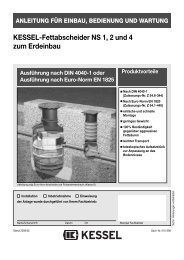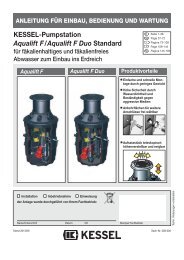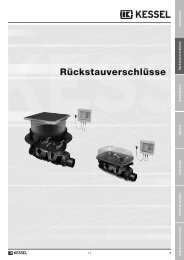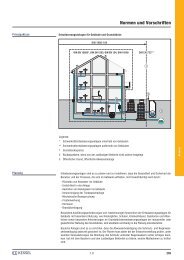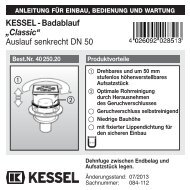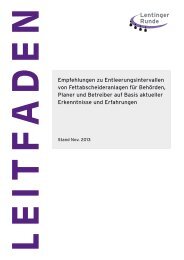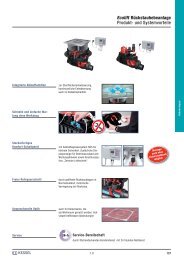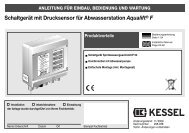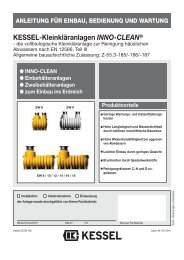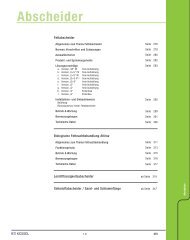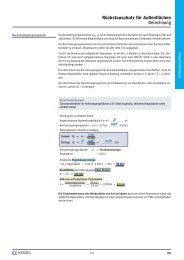KESSEL-Pumpstation Aqualift€F/Aqualift€F Duo For all wastewaters ...
KESSEL-Pumpstation Aqualift€F/Aqualift€F Duo For all wastewaters ...
KESSEL-Pumpstation Aqualift€F/Aqualift€F Duo For all wastewaters ...
Create successful ePaper yourself
Turn your PDF publications into a flip-book with our unique Google optimized e-Paper software.
6. Commissioning<br />
6.1 General instructions<br />
Please follow DIN 1986 Part 31 when commissioning pumps<br />
/ lifting stations.<br />
Caution - Before commissioning the Aqualift F make sure<br />
that <strong>all</strong> inlet pipes as well Aqualift F storage chamber and the<br />
pump is free from metal, sand or any other potenti<strong>all</strong>y damaging<br />
debris.<br />
Only place the Aqualift F into operation after it has been<br />
thoroughly checked to assure that inst<strong>all</strong>ation and pipe and<br />
electrical connection have been properly made. Make sure<br />
that <strong>all</strong> closure valves are fully open before starting<br />
Important:<br />
the commissioning of the Aqualift F must be handled by a<br />
licensed professional<br />
Make sure to follow <strong>all</strong> safety instructions in Part 1 of this<br />
User´s manual and do not place the Aqualift F in operation if<br />
the pump, control unit or cables show any signs of damage.<br />
Please make sure that the power requirements of the pumpstation<br />
match those of the power supply from the local power<br />
grid. Before placing the system in operation, re-check <strong>all</strong><br />
electrical connections. Also, make sure that <strong>all</strong> local and international<br />
regulations have been followed – especi<strong>all</strong>y those<br />
pertaining to explosion proof wastewater pumping stations.<br />
Do not use this pumping station to pump mediums for which<br />
the pumps or the pumping chamber are not intended.<br />
.<br />
Pre-check:<br />
• Operation data<br />
• Pump oil level<br />
• Impeller rotation direction<br />
• All electrical connections<br />
• Proper inst<strong>all</strong>ation of pump(s) on support feet<br />
The pump(s) must be completely filled with pumping medium<br />
(wastewater) to insure that an explosion risk atmosphere<br />
is prevented. The pump(s) can only be placed into<br />
operation when there is no chance of air entering the intake<br />
portion of the pump.<br />
Commissioning<br />
Before placing the pump(s) into operation, it must be<br />
confirmed that the wastewater level never f<strong>all</strong>s below<br />
the „Minimal Level” (see Chapter 4.4.)<br />
During continuous operation of the pumps (S1), the pumps<br />
must remain completely submerged.<br />
Operating the pumps in non submerged conditions<br />
results in an increase wear and tear on the pumps.<br />
6.1.1 Intake of floating matter<br />
Pumps with S-impellers are recommended for pumping <strong>wastewaters</strong><br />
with floating matter. In these cases, it is recommended<br />
that the pumps run in a slightly tilted position. In addition,<br />
S-impellered pumps should run for an additional 10<br />
seconds after the intake level has been reached.<br />
6.1.2 Pumping medium temperature<br />
Max pumping medium temperature of explosion rated pumps<br />
– 40 deg C.<br />
The operator of this pumpstation must insure that the<br />
operational temperature of this system (pumping medium<br />
temperature) does not exceed this level.<br />
Do not operate this system with pumping mediums<br />
above the noted maximum temperature<br />
6.1.3 Pump Starts<br />
The maximum pump starts per hour must not exceed 30.<br />
6.1.4 Operating Voltage<br />
The highest <strong>all</strong>owable departure from operating voltage is:<br />
± 10% with non explosion proof systems<br />
± 10% with explosion proof systems<br />
The maximum <strong>all</strong>owable voltage difference between the<br />
phases is 1%<br />
6.1.5 Density of Pumping Medium<br />
The max density of pumping medium is 1.1. Please contact<br />
the manufacturer for using this system with pumping<br />
mediums with a specific weight greater than 1.1.<br />
6.2 Non-operating conditions / Storage<br />
6.2.1 Storage of new pumps<br />
- Pumps should be stored in the vertical position in a dry<br />
location in their original packaging<br />
6.2.2 Requirements for longer duration storage<br />
6.2.2.1 Pump check without pump removal<br />
In order to insure proper pump operation, the pumps should<br />
be manu<strong>all</strong>y run 4 times per year for a short period of time<br />
(approx 1 minute). Pre-requisite to this check is that sufficient<br />
pumping medium is inside the pumping chamber<br />
(above Level 1 mark – see illustration on page 14)<br />
6.2.2.2 Storage of removed pumps<br />
Before storing pumps that have already been in service, <strong>all</strong><br />
check up and maintenance work should take place including<br />
lubricating the pumps as discussed in 6.2.1<br />
20



